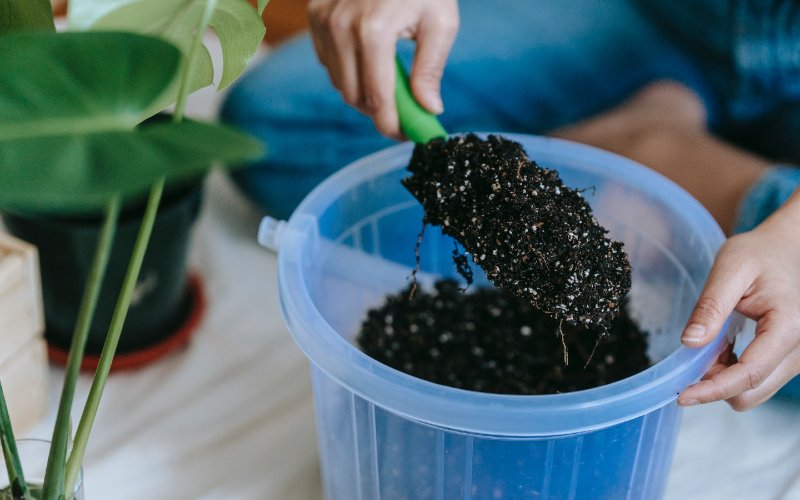5 DIY Easy Recipes for Well-Drained Soil Mix You Can Try Today
-
Codee Chessher
- Last updated:

As you likely already know, container planting is becoming increasingly popular. All you need are some seeds, pots, and soil and you’ve got yourself a nice little garden. You might consider buying the commercial soil mixes, but wait—commercial potting soil contains almost no real soil at all, and it often lacks essential nutrients that your plants crave.
The good news is that you can mix other ingredients in with commercial soil to add valuable nutrients and minerals. Let’s check out the most popular ingredients you can use to make your own potting mixes at home, and what the ratio of ingredients is.
Soil Ingredients and What They Do
There are numerous ingredients you can use to craft your own soil blend, all with their own pros and cons. You can add these to commercial potting soil to make up for its lack of nutrients compared to garden soil. Let’s check out some of the most common and useful ingredients you may want to use.
- Peat moss. Peat moss aerates the soil and retains water, so it’s a popular soil base ingredient. It may need to be amended with lime because peat moss is acidic, depending on the plants you’re growing.
- Coco coir. A byproduct of coconut processing, coco coir is a more sustainable alternative to peat moss. Coco coir has a neutral pH, making it great for any soil type.
- A small volcanic mineral that is often added to soil to promote drainage and prevent soil compaction.
- Coarse sand is one of the best ingredients to encourage soil drainage, but avoid fine sand, which can hold water like silt.
- Compost. Made from partially decomposed organic matter, compost adds nutrients and improves soil structure.
- Wood chips. Wood chips make potting soil airy and light but leech nitrogen as they degrade. Add some blood meal to counteract this effect.
- Lime. Composed of crushed limestone, lime is an alkaline compound used to temper acidic soil. Add it to acidic ingredients, like peat moss.
The 5 DIY Well-Draining Potting Soil Blend Recipes
You can use any all-purpose commercial potting soil as a base for our recipes, but it’s the other ingredients that really make the mixes special. Adjust the recipes as necessary, depending on your local climate and the plants you’re growing.
1. General Mix for Flowers & Shrubs
This soil mix is great for general-purpose gardening for flowers, shrubs, and even tropical potted plants.
- 1 part potting mix
- 1 part organic ingredient (peat moss, coco coir, or compost)
- 1 part draining agent (perlite, vermiculite, or coarse sand)
- ½ cup of lime if you’re using peat moss or acidic ingredients

2. Cactus & Succulent Blend
For cacti and succulents that need ample drainage, you’ll want a separate mix. A small bag of this will likely last a long time, provided you’re not using it for other plants.
- 1 part potting soil
- 2 parts organic ingredient (peat moss, coco coir, or compost)
- 1 part perlite
- 2 parts coarse sand
- ½ cup of lime if you’re using peat moss
3. Seed Starter Soil
Soil for starting seeds should be light but well-draining so that delicate roots aren’t swamped in stagnant water.
- 2 parts potting mix
- 2 parts peat moss or coco coir
- 1 part vermiculite
- ½ cup lime if using peat moss

4. Herbs & Veggies Soil Mix
Vegetable and herb plants need lots of nutrients to grow and produce yummy food for our dinner plates, but you can’t neglect drainage either.
- 2 parts peat moss or coco coir
- 2 parts perlite
- 2 parts compost
- 1 part coarse sand
- ½ cup of lime if using peat moss
5. Soil for Houseplants
Houseplants typically aren’t picky, so a well-balanced soil blend is perfect. Depending on the plant’s needs, you may want to amend with other ingredients, like:
- 2 parts coco coir or peat moss
- 2 parts potting mix
- 1 part vermiculite
- 1 part perlite
- ½ cup of lime if using peat moss

Conclusion
Potting soil is critical for any plants, especially if you’re container planting. Cacti and succulents need very well-draining soil, but houseplants can get away with a well-balanced blend. Customize the soil blend to better match your plants and climate!
Featured Image Credit: SHDStockProject, Shutterstock
Contents
